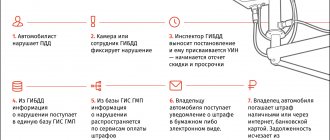Compliance with traffic rules on the road by all road users is part of the general culture . However, quite often you can encounter violations committed by both drivers and pedestrians. Such behavior on the road often turns into tragedy.
You often have to watch pedestrians cross the road in the wrong places, hoping for the discretion of the motorist, and sometimes just at random.
But the driver does not always have time to react; As a result, the pedestrian ends up in a hospital bed, or even loses his life.
Under the new rules, a driver who fails to give way to a pedestrian will pay a fine. But what if it’s not his fault? Is it possible to appeal a ticket for a pedestrian?
What is the fine for a pedestrian?
For 2021, it ranges from 1,500 to 2,500 rubles under Article 12.18 of the Administrative Code. Exactly what amount will be assigned as a sanction depends on aggravating and mitigating circumstances, and this is decided by the inspector who issues the fine. Simply put, if you admit guilt, repent of what you did, and haven’t been fined for crossing a zebra crossing for about a year before, then a minimum amount should be imposed. If failure to allow a pedestrian to pass led to an accident, and you are a repeat offender for this violation, then the maximum level of this fine may be assigned.
If a traffic violation is recorded on an auto-recording camera, then, as a rule, the maximum amount of punishment for this is assigned.
The good news is that you can appeal a fine for not allowing a pedestrian to pass at a crossing not only to cancel the penalty, but to reduce the amount.
We have a more detailed article about the penalty for this in 2021.
The above sanction may be imposed in the following cases:
- if you do not let a pedestrian pass at an unregulated pedestrian crossing (when the driver is obliged to stop if he sees pedestrians entering or crossing the roadway) - violation of clause 14.1 of the traffic rules,
- if, when turning right or left, you do not allow this category of road users to pass (13.1 Traffic Regulations),
- if you do not give the tram passengers the opportunity to get to it when the tram stops (14.6 traffic rules),
- if you do not give way to people with a white cane anywhere on the road (not only at the zebra crossing) - 14.5 traffic rules),
- if you do not allow pedestrians to complete crossing the road when the traffic light turns red for them and the light turns green for you, provided that they entered the roadway when the light turned green.
So, the fine has already been issued, what to do next?
Pedestrians and crossings: what has changed?
In 2021, penalties for both parties for violating traffic rules have been increased. Some concepts have also undergone changes.
Traditionally, a pedestrian was defined as a person walking. Now, pedestrians also include motorcyclists and cyclists who walk and roll vehicles next to them. In addition, people riding on roller skates, skis, boards, scooters and in wheelchairs are also considered pedestrians.
A pedestrian crossing is a section of road designed for people to safely cross the roadway . According to the new rules, tram tracks located in this area are also considered pedestrian crossings.
So now the tram is obliged to give way to a moving person, and not vice versa. As you know, the transition zone is indicated by road signs or markings.
All road users are required to comply with the rules prescribed by the Code of Administrative Offenses, in accordance with which everyone is responsible for their violations.
Drivers need to know when to give way to pedestrians, and people walking need to remember where to cross the street.
Deadlines for appeal
In general cases, the deadline for filing a complaint against any traffic police fines is 10 days from the date of receipt of a copy of the decision:
- from the day the inspector handed you a copy of the decision,
- from the day you took it out of the mailbox, if the fine was issued by an automatic recording camera.
Very often, motorists confuse the decree with the protocol. The first is a fine in its formal form. The latter is not appealable, but only means that the fine has not yet been imposed, but there will be a hearing at the traffic police in your presence, where you must be invited, and as a result of the analysis they will make such a decision.
If 10 days are missed, then along with the complaint you can submit a free-form petition to restore the deadlines, but there must be good reasons for this.
Theoretical aspects
If before the amendments were made to the rules, a crossing meant only a section of the road marked with two special signs, but at the moment a somewhat expanded definition has been given. A pedestrian crossing should still be understood as an area marked with two signs, but now it can cross tram tracks, which often cross the dividing marking line. This means that tram drivers are now required to let people cross the road. However, you should not cross the road to cross a moving tram - it will not always be able to brake quickly and effectively.
In the previous version of the rules, overtaking at a pedestrian crossing was prohibited only when there were people on it. This gave rise to many unfounded disputes and lawsuits because it was not regulated what could be considered to be at a pedestrian crossing (for example, when overtaking is done on the right side of the roadway, and the pedestrian is already on the left and finishes crossing the road).
IMPORTANT !!! Now it is prohibited to overtake at a pedestrian crossing in any case, regardless of the presence of people on it.
Before the 2014 changes, a driver was not required to brake or stop if a vehicle moving in the adjacent lane stopped in front of a pedestrian crossing. The only responsibility was to ensure the safety of their movement. Today, the driver must also reduce his speed if neighboring cars do so.
All of the above changes were aimed at improving road safety, primarily for pedestrians. For violation of any of the rules, the driver will be subject to administrative liability.
Form and sample complaint about a fine for a pedestrian
There is no strict appeal form for 2021. The complaint is written in free form. However, it must contain certain data:
- number of the resolution, date and time of the fine issued for the pedestrian that you are going to appeal,
- your data, including contact information,
- who issued the decree,
- reasons for canceling the fine,
- your specific requirements for the resolution (cancel, reduce the fine, and so on).
Below you can also submit complaints in DOC format for filling out on a computer or PDF for filling out by hand, as well as a sample for filling out.
- in DOC format.
- in PDF format.
- .
What are the responsibilities of a pedestrian?
Pedestrians are the most common cause of accidents. This occurs due to crossing the roadway in the wrong place. There are citizens who don’t even look around. They are convinced that they must be allowed through, but do not take into account the technical capabilities of the car. Thus, they misinterpret the rules of the road.
Attention! Pedestrians must follow traffic rules in the same way as drivers:
- Crossing the roadway should only be done in permitted places,
- at controlled crossings you can only maneuver when the traffic light is green,
- if there are no cars nearby, you can only cross the road at an angle of 90 degrees,
- It is not recommended to immediately cross the zebra crossing. You need to step on it and slow down to let drivers know your intention.
For pedestrians who do not comply with traffic rules, the law provides for fines:
- if the violation did not result in an accident, the citizen will be fined 500 rubles,
- if an obstacle was created for cars, you will need to pay 1000 rubles,
- If harm is caused to the health of third parties, the pedestrian will be fined 1,500 rubles.
Pedestrians are required to give way to an ambulance or fire truck moving with a siren at a pedestrian crossing.
Who pays the fine if the driver is driving a company car?
Instructions for appeal
Challenging a fine for not allowing a pedestrian to cross a zebra crossing is quite simple. But success depends on the grounds for appeal - if the punishment was indeed applied illegally, then the fine is also illegal and should be canceled by the person considering the complaint.
But writing a complaint correctly is half the success.
1. Fill out the complaint heading at the very top. The following information is required.
- Where and to whom you submit the application - you can appeal the fine for a pedestrian or to the traffic police - to the unit in which the inspector serves, writing a complaint addressed to his chief; or to the district court at the place where the offense was committed. All this is written on the back of the resolution. If the violation is recorded by an automatic recording camera, then the addressee will also be indicated on the back of the resolution.
- The address of the authority to which you are sending the letter is also indicated in the resolution.
- Your full name, residential address and contact telephone number for communication.
2. Now in the complaint itself you need to indicate the essence of the violation - when, where, under what circumstances, by whom or what (the camera) the decision was made.
Be careful - in the complaint you must write the date and time the traffic police fine was issued, so that it is clear that the appeal deadlines have not been missed, as well as the number of the resolution for identification.
3. Now let's move on to the most important thing - the reasons why you want to appeal the fine. We list them below. And here it is necessary to state the essence of the appeal in a free but understandable form with reference to the norms of legislation. Above in the example, we gave as an example such a basis as the absence of interference with the pedestrian by the driver’s movement, while clause 14.1 requires the driver not to interfere.
4. Now you need to write the demand itself: what do you want with this complaint - cancel the fine for not allowing a pedestrian to pass, reduce it.
5. Finally, we attach a list of documents to the complaint and indicate in the application all the attached documents.
You must include:
- a photocopy of your copy of the resolution,
- a link to a recording on YouTube, if there is a video recorder that proves your innocence (and when challenging a fine for a pedestrian, this is an important argument); pre-upload this video to the specified resource, making access only via a link, if you do not want the video to be publicly available,
- any other documents that could be relevant to the case and serve as an argument for a successful appeal (copy of the sale and purchase agreement, full names of witnesses).
Now all that remains is to sign and the current date, pack it in an envelope, and send it by mail or bring it in person to the traffic police department or TsAFAP that issued the decision, or to the district court at the place where the violation was committed. The letter must be sent by registered mail with a list of attachments.
And don’t worry about missing the appeal deadline due to the long delivery of the letter by mail - the complaint must be filed within 10 days, and you filed it by formally sending the letter, and the date of filing the complaint is considered the date the complaint was sent, indicated in the postal receipt.
In the meantime, here are a few common reasons for contestation.
Reasons
To challenge a traffic police fine for failing to let a pedestrian pass, you need to be sure of your innocence. Evidence from the video recorder and witness statements are the best defense.
Situations where a car stops at a pedestrian and allows citizens to pass, but they refuse, are common today. People deliberately throw themselves under the wheels of cars in order to receive compensation for moral and physical damage. Having a video recorder will help you challenge the traffic police fine. The recording, which will record the moment when the driver allows the pedestrian to pass, but he refuses, will automatically cancel the imposed fine.
If a driver overtakes a pedestrian and traffic police officers notice this maneuver, then a fine is issued automatically and it is impossible to challenge it. Traffic rules prohibit overtaking at a pedestrian crossing.
How to challenge and prove that you are right?
How to challenge a traffic police fine for failing to let a pedestrian pass?
You can challenge it in several ways:
- prove that the person deliberately threw himself under the wheels of a car;
- witness statements;
- prove that vehicles in front blocked the view;
- take testimony from a pedestrian.
fine for not allowing a person to pass is 1,500 rubles . This is the easiest way to punish.
You can agree with the accusations made if there really was a violation. If the driver is confident in his innocence, then he can challenge the punishment and prove that he is right. Providing a video recording is the main assistant in challenging situations. The main thing is to get your bearings in time and not miss the witnesses who could have filmed the moment of the violation.
Where to contact?
You can challenge a traffic police fine for a pedestrian by writing a statement:
- the traffic police officer who issued the ticket;
- the head of the traffic police department at the place where the resolution was issued;
- to court;
- to higher authorities responsible for road safety.
You can challenge a traffic police fine from a camera in a district court. The car owner writes a statement indicating the reasons for disagreement with the resolution. Strong evidence will help you challenge the fine issued by the traffic police.
If you have questions about how to properly file a complaint and challenge the punishment, contact our lawyer. He will help you compose your application correctly and explain where to submit it.
Sample complaint
Term
The fine is issued and the pedestrian asks the question: “Within how long can one challenge a fine for driving incorrectly at a pedestrian crossing?” It is disputed within 10 days of receiving the receipt. Within the allotted period, a complaint is filed to challenge the fine.
The complaint states:
- place of filing - court or traffic police department;
- number and date of the order issued by the law enforcement officer;
- proof of your innocence.
A complaint considered by the traffic police department is a formality. The case is being considered without the participation of the driver and witnesses. Evidence cannot be provided. The complaint is reviewed within 10 days.
It is best to submit it directly to the court, attaching all the accompanying papers. The court considers the application at the location of the violation.
There is no state fee for filing an application with the court.
Read about the fine that a driver who hits a pedestrian faces in this article:
On what basis can you appeal?
So, the list of reasons is quite large, we will present the most common ones related specifically to the refusal of pedestrians to pass.
If the pedestrian was not interfered with
Clause 14.1 of the traffic rules, if it is specifically charged with it, requires the driver to give way to a pedestrian who has entered the roadway or is crossing the road along it (at the crossing, of course). Similarly, Article 12.18 of the Code of Administrative Offenses provides for punishment specifically for failure to give way to the road.
Giving way, according to paragraph 1.2 of the Rules, means not creating interference, that is, not forcing a pedestrian to change their trajectory or speed. If this requirement is met, then there is no violation.
For example, a pedestrian has just started crossing on one side of a 6-lane road, and you are moving in a car on the other, like this:
There is no violation in this figure. But the success of appealing a fine for failure to pass here increases significantly if there is a video recorder with evidence that the pedestrian was far from the car at the time of passing the crossing.
Alas, despite the publication of an explanation by the Supreme Court that the protocol alone is not enough to impute a violation to the driver - objective evidence is needed, in practice, the courts and traffic police chiefs, when considering drivers’ complaints, still take the side of the inspectors only on the basis that the latter “has no grounds not to be trusted, because he took the oath.”
Here is an example of when a driver was issued a fine on camera, although there is no evidence that a pedestrian was obstructed (there is no answer to the question of whether the pedestrian changed speed or direction):
In the sample complaint above, we have provided the correct text of the challenge based on the lack of obstruction to a pedestrian.
If the employee has no evidence of guilt
As we have already described above, the lack of video evidence from the driver, according to the law, should not be a reason not to trust him, if the inspector does not have evidence either. But in practice, most often, those reviewing the case trust the employees. But this is not a reason to accept the fine - you need to file a complaint, simply indicating that you did not commit the offense.
Just note that the inspector may still have a video, but he is not obliged to provide it on the road upon request.
The pedestrian must be questioned
This refers to the clause about the absence of a violation due to an uncreated obstacle to a pedestrian. Even if you don't have a dash cam, the inspector is required to review the case fully, which means he is required to interview everyone involved in the situation.
You can request this in writing directly to the inspector on the road, to which he must give a reasoned refusal or still involve the pedestrian as a witness. Just make sure in advance that the pedestrian does not go further about his business by crossing the road.
However, this cannot be a separate basis for a successful appeal, but a violation of procedural norms by the traffic police officer is obvious. To do this, you can attract other witnesses, which can be stated in the protocol or resolution.
If the fine is from the auto-fixation camera
Here the list of reasons is significantly added:
- if it was not you who was driving (according to the law, fines from cameras are issued to the owner of the car), then the driver’s witness statement must be attached to the complaint about the fine for a pedestrian on a zebra crossing, and in this case the fine should be canceled against you and issued to him;
- if the car was sold, then you need to attach a copy of the purchase and sale agreement with the date of the transaction earlier than the traffic violation committed,
- if the resolution does not contain electronic signature data, then this is also a reason for canceling the fine; indicate this in the basis and refer to the norm of Article 29.10 of the Code of Administrative Offenses, as well as the corresponding resolution of the Supreme Court of the Russian Federation,
- if the camera incorrectly identified the license plates of your car, then simply indicate the correct ones in the complaint and attach a copy of the vehicle registration certificate,
- also, when issuing a fine for a pedestrian on an auto-recording camera, a photograph is always attached to a copy of your decision - in this case, you can also appeal the decision on the basis that you have complied with the requirement to give way to a pedestrian at a zebra crossing, if the photo shows that the pedestrian is far from you and the absence interference is obvious to him.
How to challenge a traffic police fine
If a motorist is sure that he has not committed any offense on the road, but is stopped by a traffic police officer who intends to issue a fine, you can try to challenge the action.
traffic police protocol for free in word format
Important! To do this you need to do the following:
- ask the traffic police officer to provide his official identification and explain the reason for the stop,
- the employee must draw up a protocol of the offense,
- It is recommended to find witnesses and pedestrians. If he finds himself on the roadway in the wrong place, you need to explain to him that he will also have to be punished. The pedestrian will have to admit that his actions are at fault, and the driver did not create obstacles for him on the road,
- You can provide DVR footage as evidence, and also seek help from witnesses.
If traffic police officers refuse to question a pedestrian, and the driver does not have a video recorder installed, this may be a scam. There is no corpus delicti in such a situation.
Therefore, employees do not draw up a protocol. But if it is drawn up, you need to study and sign the paper. Only in this case will it be possible to appeal in court.
On the back of the protocol there is a column for explanations. In it you need to describe the situation from your point of view.
To challenge a fine issued by the traffic police, you must submit an application to the head of the service within 10 days. Evidence of correctness must be attached to the complaint. This could be witness statements or video recordings.
complaints to the head of the service about a fine for not allowing a pedestrian to pass free in word format
If the supporting facts are not in favor of the driver, other methods can be used:
- indicate the use of devices by traffic police officers without a license,
- There were no witnesses when the protocol was drawn up.
A fine can also be considered illegal if the protocol was drawn up with errors.
ATTENTION! Look at the completed sample complaint to the head of the service about a fine for not allowing a pedestrian to pass:
Fine for riding on a bicycle path.
Is it possible to appeal a pedestrian ticket online?
By law no.
Update from 11/08/2018. In connection with the decision of the Supreme Court, an information footnote appeared on the traffic police website stating that appeals against fines through appeals are not carried out.
The fact is that the legislation of 2021 does not provide for filing a complaint online via the Internet, because one of the main attributes of the complaint should be the signature of the person involved - that is, yours. Thus, it is possible to challenge a fine for a pedestrian at a zebra crossing only if the applicant has an enhanced digital signature.
But with a high degree of probability, the complaint will be considered if you submit it through the online reception of the official website of the traffic police. Just write there what you would write in the form and sample complaint above.
Challenging in a judicial body
statement of claim to the court to cancel the traffic police decision free of charge in word format
You can file a judicial complaint challenging the traffic police officer’s protocol within ten days.
To challenge a pedestrian fine in court, you need to:
- write an appeal to the court, indicating passport details, registration address,
- the main text of the paper must contain references to the laws that were violated, list facts confirming the driver’s innocence,
- a request is made to interrogate witnesses to the incident,
- register a request to cancel the decision, terminate the paperwork and send it for reconsideration,
- At the end there is a list of attached documents.
When considering an appeal, the court should not focus on the decision of the traffic police officers. If the case is unsuccessful, the driver can file a claim in higher courts. The result of the appeal depends on a sufficient evidence base.
ATTENTION! Look at the completed sample statement of claim to the court to cancel the traffic police decision:
Payments for fatal accidents.
Who to sue in case of an accident, the culprit or the owner, read here.
What to do if a dog is hit by a car, read the link: https://novocom.org/poleznye-stati/sobaku-sbila-mashina-chto-delat.html
Passage of pedestrian crossings
If we are talking about controlled intersections, then everything is very simple: the driver is required to navigate by the signs of the traffic controller or by the traffic light. However, the traffic rules also include the following clause: if people do not have time to cross the roadway at their light, the driver must wait until they complete crossing the road.
Do not forget also that there is a stop line in front of controlled crossings. You cannot drive through it when there is a prohibitory signal, since you will have to pay a fine of 800 rubles for interfering with people crossing the street.
There are often situations when drivers at a signalized intersection make a right turn when the green light for pedestrians is on. In such cases, the maneuver is permitted, but you must wait until all people have crossed the road.
A significant number of questions arise regarding the passage of unregulated crossings. The motorist must adhere to the following rules:
- when driving through such a crossing, you need to assess the situation and reduce your speed;
- if a pedestrian steps onto the road, even if he is on the opposite side, he must be let through, that is, traffic must be stopped;
- in any case, it is necessary to let through blind people, people heading to a route vehicle with doors facing the roadway, or marked with a “Transportation of Children” sign;
- If vehicles in front stop when approaching an uncontrolled crossing, you are also required to stop and not overtake.
You are not required to stop if the person has not yet set foot on the roadway or is just about to cross the road.
What should be understood as a pedestrian pass?
This point is the most difficult and controversial in understanding the topic. The traffic rules, as well as the Code of Administrative Offenses, do not provide a clear definition and procedure. For this reason, drivers must independently interpret the provisions of the norm, which does not always work out correctly. The traffic rules do not require unconditional stopping or braking, since each situation on the road has different conditions. Actions aimed at providing an advantage should be taken as soon as a person steps into the pedestrian crossing area (if this area is not regulated by a traffic light).
ATTENTION !!! If crossing the roadway occurs at a prohibiting traffic light, as well as outside a zebra crossing, the driver should not unconditionally allow pedestrians to pass. This aspect is not regulated by traffic rules, but most inspectors and teachers in driving schools believe that it is necessary to pass only in designated places. Because sudden braking in a place that is not intended for this (where other drivers cannot expect it) can lead to another incident. Naturally, hitting a pedestrian is not allowed, so the driver himself needs to set priorities in each specific situation.
In the latest editions, these requirements began to apply to the tram track area. In addition, the concept of “pass” was replaced by “give in”. This is primarily due to the competition of concepts, since the term “skip” is not fixed in any way in the rules, while “give in” is contained and a clear explanation is given to it. Yielding means not performing any actions that could cause inconvenience to another participant in the movement (if he has an advantage). Inconveniences are expressed in a change in the initial speed or direction of movement.
The cyclist is now also required to give way. Bicycles are not allowed within the pedestrian zone. To cross the road you will have to dismount and walk alongside. With the introduction of this rule, drivers receive a reduction in liability for hitting a cyclist in a zebra crossing, if the violation was provoked by the cyclist himself.










